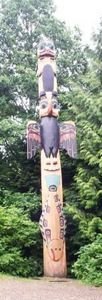Advertisement
Published: August 6th 2008

 I Finally Understand Totem Poles
I Finally Understand Totem Poles
Not objects of worship, totem poles are native to the Pacific Northwest and are records of a tale--real or mythical--that is important to a household or group. What's hot: Totem poles
What's not: Cruise fatigue
Travel lesson of the day: Take the local bus.
from Kathy:
Ketchikan is one of the rainiest cities in North America, with more than 160" of precipitation annually. Giant slugs and giant vegetation and sagging porches are testament to the humidity. We arrived at 6 a.m. to grey drizzle and learned that this could be considered a weather bonanza for Ketchikan. It is 52 degrees. The kids stayed in bed while Paul and I went exploring.
At the Native Trout Hatchery, we watched salmon struggle to make their last leaps into the hatchery pools.
A native woman explains, "Salmon die anyway once they spawn. So we kill them and donate the meat to the senior citizen home." The eggs and "milk" are kept to run the hatchery.
Notice, this is not salmon farming—a socially unpopular practice in these parts. I have seen t-shirts that say "Friends Don’t Let Friends Farm Salmon."
Main street Ketchikan, like Juneau and Skagway, is paved with jewelry stores. Unlike the other two towns, however, Ketchikan has evidence of real life. There is a real hardware

 Totem Poles Decoded
Totem Poles Decoded
There are specific shapes and symbols used by different carvers to represent the elements of the totem pole. store. There is a real bus system. There are homes and schools and other signs that make me think there's more to Ketchikan than a t-shirt shop. (I'm sure these exist in Juneau and Skagway, I just didn't see them.)
I committed another cruising heresy: I took the $1 bus ride to Saxman to visit the totem pole exhibit there. (I could have taken the $100 tour, oh well.) I was in search of an answer to the question: What is a totem pole? I saw my first pole as a little girl in Pittsburgh’s South Park, where my grandmother told me it was carved by "Indians," but she didn’t know much more about it than that. The "native American" designation was years away in those days!
Not a religious object, a totem pole memorializes the events of a story—mythical or real. The key to understanding any particular totem pole is to first know the story or event.
These poles once dotted the byways of traditional Tlingit villages, and other native villages of the Pacific Northwest, but when the people were forced to abandon their villages by missionaries, governments, or economics, the poles fell prey to rot

 Eagles in Town
Eagles in Town
Eagles were visible from many poles along the waterfront in Ketchikan. (remember that rainfall?), and other forms of destruction. Tribal groups are currently reviving and preserving the practice. New poles are being carved and old ones recarved. I visited the workshop of master carver Nathan Jackson, who happened to be at work that day.
This visit was much enriched with the narration by a former Tlingit tribal chief named Joe. He told some great totem pole stories (for instance, the William Seward ridicule pole) but his tales really came to life when he talked about hunting. "We've only ever hunted brown bears, which we usually call grizzlies," he said in the soft accent common to Native Americans here. "Not black bears. Black bears don’t taste any good."
The traditional method of bear hunting, he said, required two hunters—one strong, one fast, one to sink the knife, the other to outrun the bear.
"My mother never allowed my father to teach my brother and me the old way of bear hunting," said Joe.
He also shared that brown bears are fabulous diggers. ("Better than any backhoe I’ve ever seen.") He told of loosing a freshly killed moose carcass to a brown bear in a matter of five minutes.

 Ketchikan, Alaska
Ketchikan, Alaska
Another port town nestled along the Inner Passage. "We got distracted, the bear moved in. It buried that carcass before we ever knew what was happening. That was 20 years ago and I’m still mad about it," he said.
So went my few hours in Ketchikan, where the other worthwhile site was the National Forest Service exhibit on Southeast Alaska.
Advertisement
Tot: 0.139s; Tpl: 0.01s; cc: 10; qc: 45; dbt: 0.0571s; 1; m:domysql w:travelblog (10.17.0.13); sld: 1;
; mem: 1.1mb

 I Finally Understand Totem Poles
I Finally Understand Totem Poles
 Totem Poles Decoded
Totem Poles Decoded
 Eagles in Town
Eagles in Town
 Ketchikan, Alaska
Ketchikan, Alaska